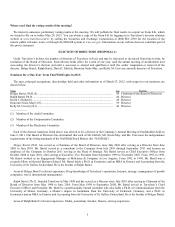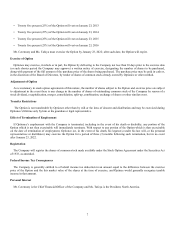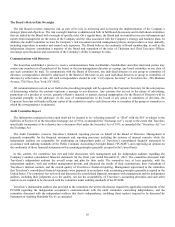Travelzoo 2011 Annual Report Download - page 14
Download and view the complete annual report
Please find page 14 of the 2011 Travelzoo annual report below. You can navigate through the pages in the report by either clicking on the pages listed below, or by using the keyword search tool below to find specific information within the annual report. 13
compensation except for the granting of stock options to Mr. Ceremony and Ms. Tafoya to further align interests of these executives to
stockholders.
Overview of Compensation Program
The following Compensation Discussion and Analysis, or “CD&A,” describes our overall compensation philosophy and the
primary components of our compensation program. Furthermore, the CD&A explains the process by which the Compensation
Committee, or “Committee”, determined the 2011 compensation for our Chief Executive Officer, Chief Financial Officer and other
most highly compensated officers. We refer to these individuals collectively as the “named executives” or the “named executive
officers.”
Compensation Philosophy and Objectives
The fundamental objectives of our executive compensation program are to attract and retain highly qualified executive officers,
motivate these executive officers to materially contribute to our long-term business success, and align the interests of our executive
officers and stockholders by rewarding our executives for individual and corporate performance based on targets established by the
Committee.
We believe that achievement of these compensation program objectives enhances long-term profitability and stockholder value.
The elements utilized to help achieve the Committee’s objectives include the following:
• Accountability for Individual Performance. Compensation should in large part depend on the named executive’s individual
performance in order to motivate and acknowledge the key contributors to our success.
• Recognition for Business Performance. Compensation should take into consideration our overall financial performance and
overall growth.
• Attracting and Retaining Talented Executives. Compensation should generally reflect the competitive marketplace and be
designed to attract and retain superior employees in key competitive positions.
We implement our compensation philosophy through setting base salaries for our executive officers, through the use of our
executive bonus plan and through reviewing and approving other terms of employment agreements.
Compensation Determination Process
Compensation Committee Members. The Committee is responsible for establishing, overseeing and reviewing executive
compensation policies and for approving, validating and benchmarking the compensation and benefits for named executive officers.
The Committee is also responsible for determining the fees paid to our outside directors. The Committee includes Ms. Kelly M. Urso
(Chair) and Mr. Holger Bartel. Ms. Urso satisfies the independence requirements of the NASDAQ. The Compensation Committee
does not have a charter.
Role of Management. During 2011, the Committee engaged in its annual review of executive compensation with the goal of
ensuring the appropriate combination of fixed and variable compensation linked to individual and corporate performance. In the
course of its review, the Committee considered the advice and input of the Company’s CEO and data prepared by management,
including a comparison of the current compensation of the named executive officers with publicly available industry data from The
Wall Street Journal. The Wall Street Journal data utilized by the Committee included salary and total compensation information based
on the title, job description, and geographic location of similarly situated executives. The most significant aspects of the CEO’s role in
the compensation determination process are evaluating employee performance, establishing business performance targets, goals and
objectives and recommending salary and bonus levels. The CEO does not participate in discussions regarding his compensation.
The Committee compared the compensation received by the Company’s named executive officers with the levels of compensation
received by similarly situated executives in the same geographic location in light of the named executives’ responsibilities,
performance, experience and tenure, in order to arrive at the total compensation package for each of the named executive officers. In
some cases, the compensation package that the Committee awarded a named executive officer was at or below the median
compensation received by executives per The Wall Street Journal data, while in other instances the compensation was higher due to
the executive’s responsibilities, performance, experience and tenure.
























